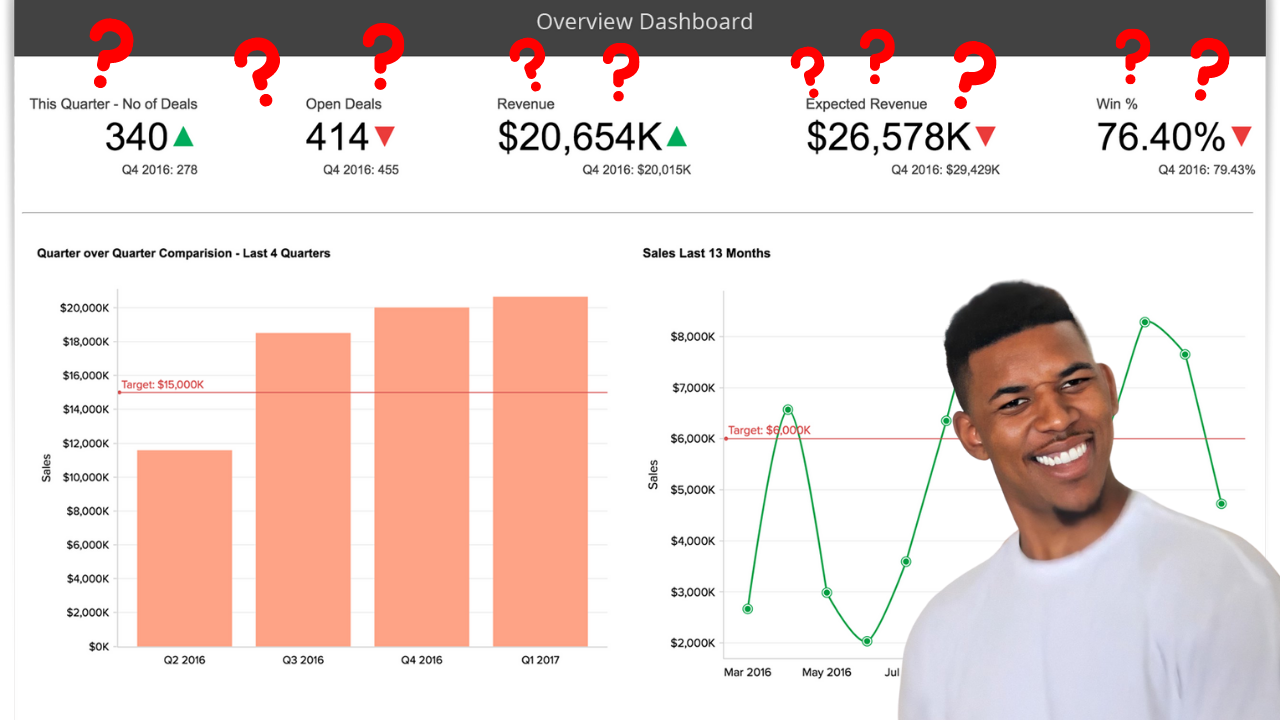As an online business owner, you have chosen to partake in a never-ending contest of survival in a treacherous arena. An arena riddled with unexpected barriers and where the rules of engagement are constantly changing.
In an attempt to be one of the few winners of this competition, there are businesses who decide to approach this game through collaboration, relying on strategic partnerships with other competitors for survival. On the other hand, there are those who instead adopt the kill or be kill mentality ( … cough Amazon … cough Facebook), crushing all who dare to enter into their territory.
Regardless of the approach you decide to take, the winners will be those who understand the power of data. The ones who know how to identify the data points needed to materialize information and knowledge that will allow them to achieve their objectives.
These data points are known as KPIs.
What are KIPs?

KPI is an acronym that stands for Key Performance Indicator. At its essence it is a statistic that can be used as quantifiable measure of performance for a specific objective over time. They are present in literally every aspect of your business and can be used to identify important measurable goals, track performance, maintain focus, and enable better informed decision making.
KPIs vs Business Metrics
Superficially KPIs and business metrics appear to be the same thing however, because the difference in their intended purpose, is important to understand the distinction.
A KPI is a statistic that specifically and directly affects the outcome of an important business outcome (e.g., number of new subscriptions per month). A business metric, on the other hand, is simply a measure of an arbitrary business activity (e.g., number of website visits per month).
Essentially, all KPI’s are metrics, but not all metrics are KPI’s. In order to become one of the winners in the online marketplace you will need the ability to identify the KPIs that exist within your metrics.
Identifying Your KPI’s

Every online business is in some way unique. Whether it is the actual product and/or service being sold, the physical and sociological circumstances to which the owner of the business is operating, or simply the specific outcomes that are important to the founder.
When considering the idea of KPIs in a business context, it is important to first recognize what is unique about the objectives of your business before attempting to identify and track them.
Needless to say, if you are going to utilize KPIs to dictate the priorities of your business you better make sure that you are actually using the ones that are relevant to your specific situation and sensibilities. Get this wrong and you will inevitably deviate from your intended path, potentially anchoring yourself to a position that in no way matches the original vision for your company.
To avoid this, I recommend taking the following approach:
- Write down your personal goals for your business. Not just from a monetary standpoint, but also in regards to ethics and your desired lifestyle.
- Utilize Google or your preferred search engine to discover the KPIs used in businesses similar to yours and/or in the same industry. Ensure that you record every KPI you find.
- Using your original list of goals, aggressively remove every KPI that does not directly align with your vision for your company. This is very important as it will keep you laser focused on the most optimal path to achieving your personal objectives.
Though it can be tempting to track every KPI that could potentially indicate positive progress in your business, in my option this is usually not a good idea as it will cause you to miss your true targets and will likely also lead to information overload. Taking this approach will allow you to develop a short but effective list if measurable statistics, resulting decisions that will impact your business in the way you originally intended.
Tracking your KPIs
You have developed your list of desired indicators, so it is now time to start collecting your data. Of course, there are multiple approaches you can take to KPI tracking and visualization. The one that will work best for you depends on the strain of online business you are operating, as well as the type of KPI you need to track.
Automated KPI Tracking with Google Analytics
For full disclosure, I am totally in love with Google Analytics. We are actually already engaged and scheduled to get married next week.
In all seriousness, if the KPIs you need to track are all “digital” in nature and can be captured directly from your website/app, Google Analytics is by far the best free tool you can use to manage and visualize your KPIs.
Google Analytics contains a system they refer to as “goals”. Google Analytics’ goals are extremely flexible and can be used to track almost any action that takes place on pretty much any digital platform (e.g., Mobile Apps, Websites etc.). Using goals to record your KPIs means that you will have a completely automated system for tracking your key indicators, significantly reducing the overhead, and removing all potential for human error.
Google Analytics not only gives you the ability to automatically generate monthly, weekly and yearly KPI reports, but also allows you to visualize the customer behaviors that led up to the completion of your goal/KPI. Access to this customer behavior flow make it much easier to determine what specifically needs to be changed in order to achieve the objectives being tracked by your KPIs.
KPI Aggregation
The downside of Google Analytics is that it only allows you to track KPIs that can be directly captured through a digital medium. Depending on what data you need to measure this will not be sufficient to provide you with all of the information needed to fully inform your decision making. If you need to track KPIs that more palpable in nature, or KPIs that for whatever reason will require direct human input, here are some other options:
Use Dedicated KPI Tracking Software
There are a wide variety of software on the internet specifically tailored to KPI tracking. And, unlike Google Analytics, many will allow you to manually add data points. If you are going to take a non-automated approach to KPI tracking utilizing one of these products is your best bet.
Most if not all of them provide automated reporting as well as a single location though which you can visualize your KPIs. Some even integrate with third party software like Google Analytics, Quickbooks and Zoho CRM, allowing you to mix of both automated and manual KPI tracking. These, in my opinion, are the top 3 options:
- Qlik.com
- Scoro
- Datapine
Use Microsoft Excel
If you are a glutton for punishment you can also consider using something like Microsoft Excel or Google Spreadsheets. If you know what you are doing, with these tools it is actually possible to create a rudimentary dashboard for visualizing your KPIs. In fact, I have actually seen some fairly large business use Microsoft Excel for this very purpose.
Of course, in my opinion this is not an ideal solution as it will require you to not only become a Microsoft excel wizard, but also coordinate data entry amongst your team members to minimize the impact of human error.
Optimizing Your Business By Developing A KPI Strategy

In order to ensure that your key performance indicators are actually delivering the results you expect, you need to develop a plan of action dictating how and when you will make adjustments to your business based on the information you are gathering.
In many ways this is more difficult than discovering and tracking the KPIs themselves, however it is a necessary evil if you want to reap any benefit from your investment.
My suggestion is to take the following approach:
Step1
After you first set up KPI tracking, schedule a specific day and time each week/month to review the results on your KPI report. Essentially, you are determining your measurement frequency, which moving forward I will be referring to as your observation period. Do not take any action based on the results you are seeing; you goal here is to simply determine the base figures for the KPIs you are tracking. You will need to do this for at least 3 observation periods to get a good sense of what your numbers tend to look like without any intervention.
Step 2
For every KPI you are measuring, set a realistic number you would like to reach. In addition to this, you will need to record both the customer facing and behind the scenes systems that are taking place in order to facilitate the achievement of this KPI.
Step 3
Once you have completed your initial 3 observation periods, your next step is to set goals for your next one. At the beginning of the next period, make a slight adjustment to at least one of the systems involved in completing the KPI. Consider this an iteration.
Step 4
At the end of this observation period, verify if the change you have implemented has had a positive or negative effect on your KPI.
Step 5
If your change had a positive effect, move onto a different KPI and do the same thing. If it had a negative effect, make another iteration to the problem system … rinse and repeat until you see a positive change.
Conclusion
Utilizing KPIs to optimize and grow your business is an exercise in accuracy, patience, consistency, and self-discovery. In order to truly harness the power that KPIs can offer you will need to discard your emotions and develop an obsession with data.
If you do not want to go through the trouble of configuring KPI software, or are interested in setting up automated KPI tracking though Google analytics, scroll down and get in touch with me. I have done this dozens of times and have the experience to help you determine which statistics need to be tracked to allow you to best impact your business. I also have the technical resources to automate the tracking and reporting of these metrics, which will save you a huge amount of time depending on how many KPIs you need to track.